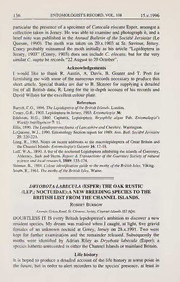
Dryobota labecula (Esper) the oak rustic (Lep.: Noctuidae): a new breeding species to the British list from the Channel Islands PDF
Preview Dryobota labecula (Esper) the oak rustic (Lep.: Noctuidae): a new breeding species to the British list from the Channel Islands
136 ENTOMOLOGIST'S RECORD, VOL. 108 15.V.1996 particular the presence of a specimen of Catocala elocata Esper, amongst a collection taken in Jersey. He was able to examine and photograph it, and a brief note was published in the Annual Bulletin ofthe Societe Jersiaise (Le Quesne, 1990). The moth was taken on 20.x.1903 at St. Saviour, Jersey. Coney probably misnamed the moth initially as his article "Lepidoptera in Jersey, 1903" (Coney, 1903) does not include C. elocata, but for the very C similar nupta he records "22 August to 20 October". Acknowledgements I would like to thank R. Austin, A, Davis, B. Goater and T. Peet for furnishing me with some of the numerous records necessary to produce this short article. Special thanks are due to B. Skinner for supplying a detailed list of all British data; R. Long for the in-depth account of his records and David Wilson for the excellent colour plate. References Barrett, C.G., 1896. TheLepidoptera oftheBritishIslands. London. Coney, G.B., 1903. LepidopterainJersey, 1903. Entomologist36: Edelston, H.G., 1860. Captures, Lepidoptera. Bryophila algae Fab. Entomologist's WeeklyIntelligencer7:11. Ellis, 1890. TheLepidopterousfauna ofLancashireandCheshire. Warrington. LeQuesne, W.J., 1990. Entomology Section report for 1989. Ann. Bull. SocieteJersiaise IS: 220-223. Long. R., 1965. Notes on recent additions to the macrolepidoptera ofGreat Britain and the Channel Islands. Entomologist's Gazette 16: 17-18. Luff, W.A., 1890. A list ofthenocturnalLepidoptera inhabiting the islands ofGuernsey, Aldemey, Sark and Herm. Report & Transactions ofthe Guernsey Society ofnatural science andlocalresearch. 1889: 155-174. Skinner, B., 1984. Colour identificationguide to themothsoftheBritishIsles. Viking. South, R., 1961. Themoths oftheBritishIsles. Wame. DRYOBOTA LABECULA (ESPER) THE OAK RUSTIC (LEP.: NOCTUIDAE):A NEW BREEDING SPECIES TO THE BRITISH LIST FROM THE CHANNEL ISLANDS. Robert Burrow Lesmin,GreenRoad,St. Clement,Jersey,ChannelIslandsJE2 6QA. DOUBTLESS IT IS every British lepidopterist's ambition to discover a new resident species. My dream was realised when I caught, at light, five gravid females of an unknown noctuid at Gorey, Jersey on 28.x.1991. Two were kept for further examination and the remainder released. Subsequently the moths were identified by Adrian Riley as Dryobota labecula (Esper); a species hitherto unrecorded in eitherthe Channel Islands ormainland Britain. Life history It is hoped to produce a detailed account of the life history at some point in the future, but in order to alert recorders to the species' presence, at least in DRYBOTA LABECULA IN JERSEY 37 1 the Channel Islands, it was considered desirable to publish the discovery immediately. In the meantime the following brief account is gleaned from Foster and Wohlfart. The adults fly between October and December, during which time ova are laid on holm oak Quercus ilex. After overwintering they hatch during April and May. The larvae pupate in September. Status in the Channel Islands The few collectors and recorders in Jersey rarely, if ever, use light-traps during the flight period of this species. This suggests the moth may have long been present in the Island but merely overlooked. Moreover, as holm oak is one of the more common trees here it was possible D. labecula was also widespread. During the late autumn and early winter of 1992, unfavourable weather conditions precluded light-trapping. However the mild weather of 1993 led to the discovery of four new sites at widely separated localities across the Island. In 1994 a further two new sites were found, confirming the species to be widespread and not uncommon. To date I have recorded a total of seventeen individuals from six localities. A further two individuals were caught in the Rothamsted Insect Survey light-trap at Trinity on 25. and 29.x.1995. The moth has now been recorded in Guernsey, with singles to light at Pleinmont on 13 and 28 October. A specimen was taken at Les Sages on 21 October with a further four at the same location the following day. & It will be noted from the photograph (Plate D, Figs. 9 10) that there are two forms of the moth based on the colour of the reniform stigma. In the specimens I have examined there appears to be no further significant variation. In the systematic list, this species should be placed between 2243: Xylocampa areola Esp. and 2244: Meganephria bimaculosa (L.). It is suggested that the number 2243a should apply. Acknowledgements Thanks are extended to Adrian Riley, lACR Rothamsted, for identifying the original specimens and forhis assistance in drafting this article. References Forster,W. & Wohlfart, T.A., 1963.DieSchmetterlingeMitteleuwpas4: 197-198. Leraut, P., 1980. Liste Systematique et Synonymique des Lepidopteres de France, Belgique etCorse. Suppl. Alexanor. Paris. The Large White butterflyPieris brassicae (L.) (Lep.: Pieridae) in Shetland The Large White was obviously scarce or rare in Shetland at the end of the last century and the beginning of this. Beime (1945, Efit. Rec. 51: 37-40) could not trace any original records nor find any specimens although he noted that some authors had included Shetland in the species' distribution.
